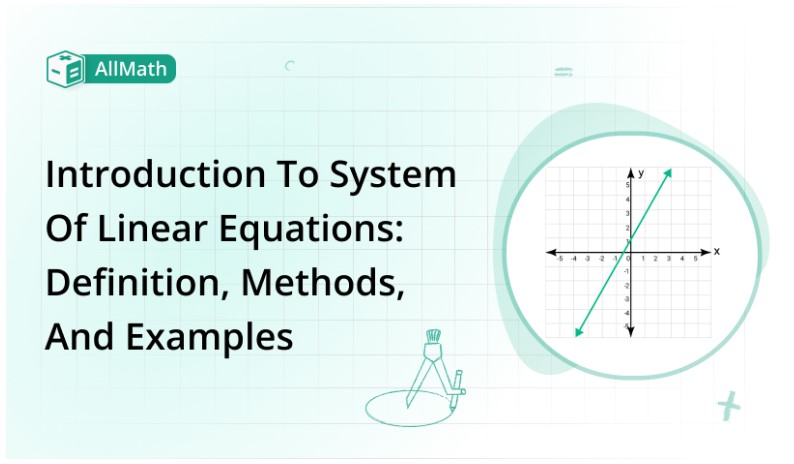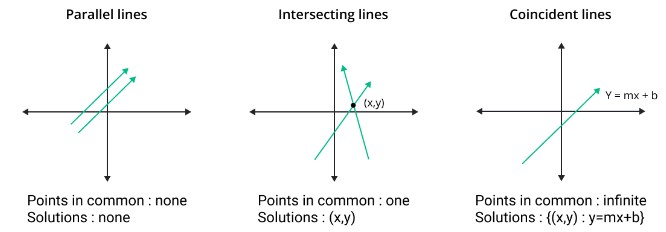To calculate result you have to disable your ad blocker first.
Introduction to System of Linear Equations: Definition, Methods, and Examples

Publish Date: 08 Aug, 2023
Table of Content
Linear equations are fundamental building blocks in mathematics, and a system of linear equations involves multiple such equations working together.
This article provides an overview of the system of linear equations and introduces the elimination and substitution methods as techniques to solve them.
System of Linear Equations - Definition
A system of linear equations is a collection of two or more linear equations that involve the same variables. In simple terms, we are trying to find the values of the variables that satisfy all of the equations simultaneously.
A system of linear equations can have one unique solution, infinitely many solutions, or no solution at all.
Graphical Representation
Before diving into the solution methods, it is helpful to visualize a system of linear equations through graphical representation. Each linear equation can be represented as a straight line on a Cartesian plane.
The point(s) at which the lines intersect represents the solution to the system of linear equations. If the lines never intersect, there is no solution. If the lines coincide, there are infinitely many solutions.

Methods to solve a system of linear equations:
There are quite a number of methods to solve linear equations. For example:
- Substitution method
- Elimination method
- Cramer’s rule
- Matrix method
- Row reduction
- Iterative methods e.t.c
But the easiest and most common among the math folk are the first two. Let’s learn more about elimination and substitution methods.
Elimination Method
The process of solving a system of linear equations involves simplifying a pair of equations containing two variables into a single equation with one variable. The elimination method helps us achieve this goal by either adding or subtracting the equations, thus eliminating one variable in the process.
Consider this distinct system of linear equations:
4x - 2y = 10
3x + 2y = 14
Using the elimination method, we ensure that the equality of the equations is maintained while performing operations on both sides.
In this example, the two equations can be directly added because the coefficients of the y variable in both equations are additive inverses (+2 and -2). By adding the two equations, the y variable is removed:
(4x - 2y) + (3x + 2y) = 10 + 14
7x = 24
Now we have a simplified equation with only one variable, x, which can be solved:
7x = 24
x = 24/7
With the value of x determined, substitute it back into either of the original equations to solve for y. Let's use equation 1:
4(24/7) - 2y = 10
96/7 - 2y = 10
Now we can solve for y:
2y = 96/7 - 70/7
y = (96 - 70) / (2 * 7)
y = 13/7
So, the solution to the system of linear equations is x = 24/7 and y = 13/7.
At times, you might encounter a system of linear equations where the coefficients cannot be directly eliminated. In these cases, you'll need to manipulate one or both equations by either multiplying or dividing to match a pair of coefficients.
How to use the elimination method?
To apply the elimination method for solving a system of linear equations, follow these steps:
- Find a pair of terms in the system with the same variable and coefficients of equal magnitude. If necessary, rewrite one or both equations to match the coefficients.
- Add or subtract the two equations in the system to eliminate the terms identified in Step 1, resulting in a linear equation with only one variable.
- Solve the linear equation to obtain the variable's value.
- Insert the value of the determined variable back into one of the original equations to find the value of the remaining variable.
Substitution Method
The substitution method is another approach to solving a system of linear equations that involves isolating one variable in one equation and substituting its expression into the other equation. This method simplifies the problem into a single equation with one variable, making it easier to solve.
Let's consider a different system of linear equations:
x + y = 9
2x - 3y = 4
In this example, start by isolating one variable in one of the equations, say x in equation 1:
x = 9 - y
Now that the expression for x is in terms of y, substitute this expression into the other equation (equation 2) in place of x:
2(9 - y) - 3y = 4
18 - 2y - 3y = 4
This substitution transforms the equation into a single-variable linear equation, which can now be solved:
18 - 5y = 4
5y = 14
y = 14/5
With the value of y determined, substitute it back into the expression we found for x:
x = 9 - 14/5
x = (45 - 14) / 5
x = 31/5
So, the solution to the system of linear equations is x = 31/5 and y = 14/5.
The substitution method is especially useful when one variable can be easily isolated in one of the equations or when one of the variables already has a coefficient of 1 or -1.
How to use the substitution method?
To use the substitution method for solving a system of linear equations, follow these steps:
- Isolate one variable in one of the equations (express the variable in terms of the other variable).
- Substitute the isolated variable's expression into the other equation in the system, resulting in a single-variable linear equation.
- Solve the single-variable linear equation to determine the value of the variable.
- Replace the value of the found variable back into the expression for the isolated variable in the first equation to find the value of the other variable.
FAQs:
Q.1 When should I use the elimination method, and when should I use the substitution method?
The choice between elimination and substitution methods is often based on personal preference or the specific characteristics of the given system.
The elimination method might be more straightforward when the coefficients of one variable are equal or additive inverses, while the substitution method can be useful when one equation can be easily solved for one variable.
Q.2 How do I know if a system of linear equations has no solution or infinitely many solutions?
If you manipulate the equations and end up with a contradiction, such as 0 = 1, the system has no solution. If you obtain an identity, like 0 = 0, after manipulation, the system has infinitely many solutions.
Q.3 Can these methods be applied to systems with more than two variables?
Yes, both the elimination and substitution methods can be extended to solve systems with more than two variables. However, the process may be more complex and involve additional steps.

